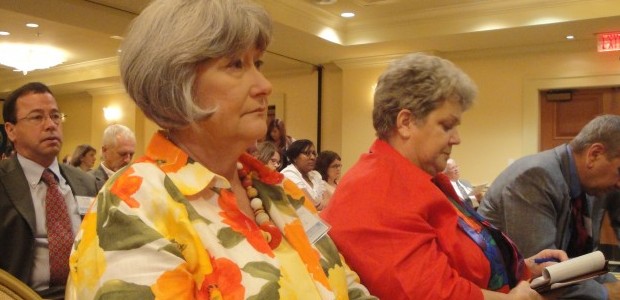Crime Blotter: Reported offenses in the Tri-parishes
August 23, 2012Truck destroys Leeville toll kiosk
August 23, 2012The Restore Act promises oil-spill fines from the Clean Water Act to filter into local coffers, but leaders are waiting to learn not only how much money may be headed their direction, but also what requirements will be attached.
Passed by Congress in late June, the Restore Act dedicates 80 percent of the fines resulting from the April 2010 explosion of the Deepwater Horizon oil platform and resulting spill to restoration of the Gulf Coast ecosystem and economy. Those fines are expected next year, after a scheduled civil trial.
That amount could be as high as $16.8 billion, Myrtis Franke, Southern District Director for U.S. Sen. Thad Cochran, told a crowd at the Gulf Coast Restoration Summit Friday in New Orleans. While 60 percent of the dollars will be sent to the Gulf Coast Ecosystem Restoration Council for implementation of its comprehensive federal environmental plan, the 35 percent earmarked for the five affected states for environmental and economic restoration could net each state as much as $1.16 billion.
Thirty percent of Louisiana’s share will be sent directly to the affected coastal parishes, Franke said, while 70 percent goes to the state, giving the respective governors “a lot of impact” on spending.
Henri Boulet, executive director of the LA 1 Coalition, who attended Friday’s conference seeking opportunities for elevation of La. Highway 1 from Golden Meadow to Leeville, is focusing his efforts on ensuring the governor’s Office of Coastal Activities, the Gulf Coast Restoration Task Force and other agencies have the latest studies illustrating Highway 1’s vulnerability. A NOAA study reports that section of Highway 1 will be deemed undependable by 2030, with it being inundated with water 6 percent of the time, and the U.S. Department of Homeland Security reports washout of the highway to impact the national gross domestic product by $7.8 billion.
“It’s tough to get federal dollars because La. 1’s a state highway,” Boulet said, so it’s not part of the federal obligation. “It’s a fierce round robin,” he said, where federal departments that acknowledge the highway’s value refer him back to the state, and the governor asks him to seek federal dollars. But the federal transportation department will only accept an application for the final 20 percent of the project, Boulet said, so the ball lands back in the state’s court.
“I think we need the money sooner than later – that time and tide are not on our side,” Boulet said, so he’s hoping a settlement is reached quickly and the dollars start flowing soon. “If as NOAA reports, we’ve got to have something built by 2030 (and if that takes three different segments of construction), we’ve got to start building soon.”
Garret Graves, chairman of Louisiana’s Coastal Protection and Restoration Authority, has stated that the state’s early priority lies in the implementation of the 2012 Master Coastal Plan. The 50-year plan includes 109 projects aimed at benefiting communities and coastal ecosystems. It includes the Morganza to the Gulf hurricane protection system, installation of water control structures in the Chacahoula Basin, and creation of marsh in North Terrebonne Bay, Terrebonne Basin and from Belle Pass to Golden Meadow.
That 30 percent for affected coastal parishes could total $348 million. Those dollars can be spent on environmental restoration, mitigation to damage to natural resources, implementation of approved marine coastal management plans, workforce development and job creation, improvements for state parks, infrastructure projects benefiting the economy or ecological resources, coastal protection, planning assistance and administration costs of compliance, and tourism, according to Nicholas Matherne, Terrebonne Parish’s coastal zone manager.
Aside from not knowing the actual dollar amount to be received, Matherne said the challenge for local officials lies in a lack of federal guidance on what’s required to receive or implement the dollars. Parishes must have a comprehensive land-use plan to receive the dollars, but he said guidance is needed to know whether that means zoning is required throughout the parish, or if a plan that discussing land use, developable land and targeted industrial areas is sufficient.
“We’re hoping for the federal government to say ‘Here’s your allocation’… then get out of the way and let us do what we need to do on the local level,” Matherne said. Past programs have required such detailed documentation that problems have worsened before dollars and solutions could be implemented.
Matherne said Terrebonne officials have not decided upon a list of priority projects to be implemented with these dollars, nor is one being required at this time, but the parish does have a coastal master plan as a starting point and such identified needs as the Morganza-to-the-Gulf hurricane protection system and sediment diversion from the Atchafalaya Basin.
Sharon Alford, executive director of the Houma-Terrebonne Convention and Visitor’s Bureau, Carolyn Cheramie, of the Bayou Lafourche Convention and Visitor’s Bureau and Henri Boulet, executive director of the LA 1 Coalition, listen to discussions about the fines being generated from the 2010 Deepwater Horizon oil spill at the Gulf Coast Restoration Summit Friday in New Orleans.









